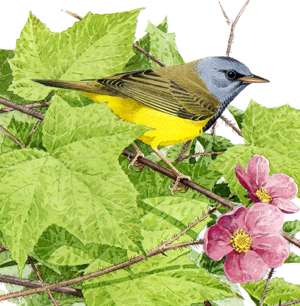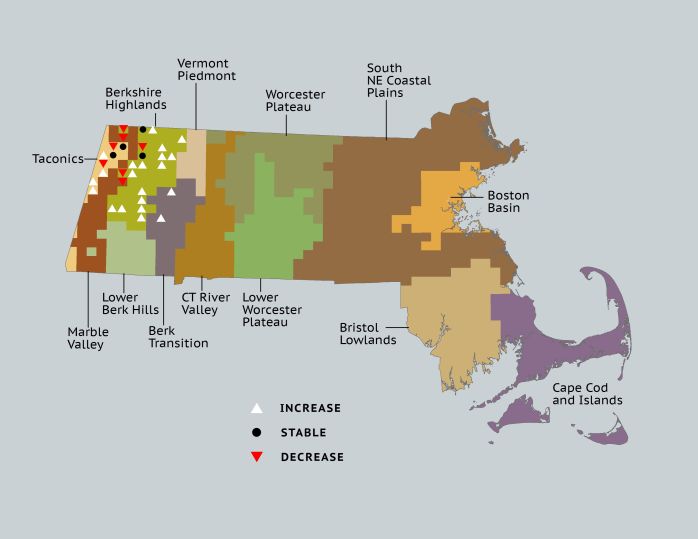Find a Bird
Mourning Warbler
Oporornis philadelphia

Local and strongly increasing
Species of Special Concern
“This crêpe-like marking about the breast is the only thing about the bird that would suggest mourning, for it seems as happy and active as most birds, and its song is a paean of joy.” – Edward Howe Forbush, Birds of Massachusetts and Other New England States
This reclusive warbler was not named for any particular tendency toward grief. Rather, the name comes from the ashy head and black throat of the breeding male, which give it the appearance of wearing a mourning veil. The Mourning Warbler is a shy bird, prone to hiding in the deep undergrowth for extended periods, and thus seldom seen. As a species that thrives in areas of disturbed forest, the Mourning Warbler sometimes benefits from the expansion of human enterprise. Land clearing may lay the groundwork for what could someday be new Mourning Warbler habitat, once it has become properly overgrown with saplings, currants, bunchberries, briars, and wild roses.
Historic Status
The life history of the Mourning Warbler was a work in progress in the middle of the 1800s in Massachusetts. “Very little is known of its habits,” wrote William Peabody near the middle of the nineteenth century, “and I believe, nothing whatever of its nest,” (Peabody 1839). Still, the species was seen in the state from time to time. It took a trip to Mount Greylock by William Brewster in the summer of 1883 to find them in abundance, to use his word, and at that point their secret to breeding in Massachusetts was discovered: high elevation combined with appropriate habitat (Petersen & Meservey 2003). Preferring habitats at 1,200 feet or higher, they sought Massachusetts mountaintops, historically Savoy Mountain as well as Mount Greylock. The Civilian Conservation Corps’ road-building project and subsequent vehicular traffic may have displaced the species to the lower slopes of Mount Greylock as it sought to find suitable early successional nesting habitat.
Atlas 1 Distribution
Surveys conducted during Atlas 1 reinforced the reputation of Mourning Warblers as local and secretive summer residents in the Bay State. Evidence of breeding was found in only 11 blocks, and all of these were in the northwestern corner of the state. Scrubby areas at high elevations are the species’ preferred milieu, so not surprisingly 9 out of the 11 blocks where the species was found were on the slopes of the Taconic Mountains (4 blocks) and the Berkshire Highlands (5 blocks). The remaining 2 blocks were in the northernmost reaches of the Marble Valleys ecoregion.
Atlas 2 Distribution and Change
Though this warbler is named for the black-and-grey pattern on its head and breast suggestive of a mourner’s attire, its cheery song belies its somber sobriquet. In Atlas 2, this species apparently underwent a small, but notable, expansion in the northwestern part of the state, bringing its statewide total of occupied blocks to 29. The Berkshire Highlands accounted for most of the breeding Mourning Warblers in the Bay State, but the species also had a presence in the Taconics, and it was Confirmed breeding in the Berkshire Transition zone.
Atlas 1 Map

Atlas 2 Map

Atlas Change Map

Ecoregion Data
Atlas 1 | Atlas 2 | Change | ||||||
Ecoregion | # Blocks | % Blocks | % of Range | # Blocks | % Blocks | % of Range | Change in # Blocks | Change in % Blocks |
Taconic Mountains | 4 | 25.0 | 36.4 | 9 | 36.0 | 31.0 | 2 | 13.3 |
Marble Valleys/Housatonic Valley | 2 | 5.1 | 18.2 | 0 | 0.0 | 0.0 | -2 | -5.1 |
Berkshire Highlands | 5 | 9.1 | 45.5 | 17 | 30.9 | 58.6 | 12 | 22.6 |
Lower Berkshire Hills | 0 | 0.0 | 0.0 | 0 | 0.0 | 0.0 | 0 | 0.0 |
Vermont Piedmont | 0 | 0.0 | 0.0 | 1 | 5.9 | 3.4 | 0 | 0.0 |
Berkshire Transition | 0 | 0.0 | 0.0 | 2 | 5.0 | 6.9 | 2 | 6.5 |
Connecticut River Valley | 0 | 0.0 | 0.0 | 0 | 0.0 | 0.0 | 0 | 0.0 |
Worcester Plateau | 0 | 0.0 | 0.0 | 0 | 0.0 | 0.0 | 0 | 0.0 |
Lower Worcester Plateau | 0 | 0.0 | 0.0 | 0 | 0.0 | 0.0 | 0 | 0.0 |
S. New England Coastal Plains and Hills | 0 | 0.0 | 0.0 | 0 | 0.0 | 0.0 | 0 | 0.0 |
Boston Basin | 0 | 0.0 | 0.0 | 0 | 0.0 | 0.0 | 0 | 0.0 |
Bristol and Narragansett Lowlands | 0 | 0.0 | 0.0 | 0 | 0.0 | 0.0 | 0 | 0.0 |
Cape Cod and Islands | 0 | 0.0 | 0.0 | 0 | 0.0 | 0.0 | 0 | 0.0 |
Statewide Total | 11 | 1.1 | 100.0 | 29 | 2.8 | 100.0 | 14 | 1.7 |
Notes
The Mourning Warbler shows a significant decreasing Breeding Bird Survey trend in the Eastern US overall.



